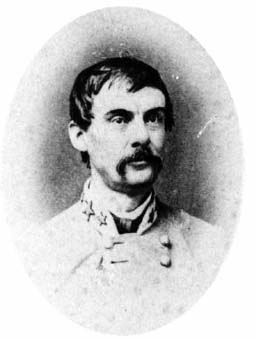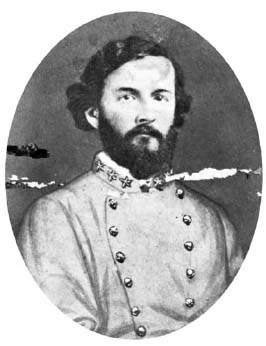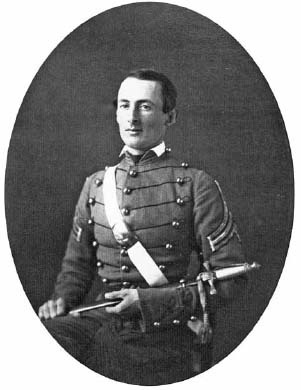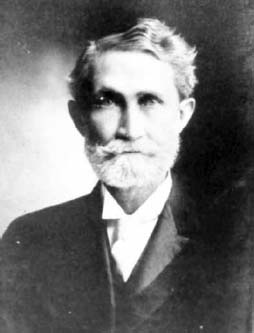The Battle of White Sulphur Springs (9 page)
Read The Battle of White Sulphur Springs Online
Authors: Eric J. Wittenberg


Brigadier General John Echols, commander of Echols's brigade. Detached duty meant that Echols was not in command of his brigade at White Sulphur Springs.
Library of Congress
.

Colonel George S. Patton, commander of Echols's brigade at White Sulphur Springs.
National Archives
.
Patton was born in Fredericksburg, Virginia, in 1833. He was the grandson of General Hugh Mercer, the Revolutionary War hero mortally wounded in action during the Battle of Princeton, and was the grandfather of his famous namesake, the World War II hero General George S. Patton Jr. He was tall and slender and had dark, curly hair and dark eyes. Colonel Patton graduated second in the Virginia Military Institute class of 1852 and then helped to found a private school in Richmond, where he served as assistant principal and taught mathematics and English, all the while studying law in the hope of joining the Virginia bar.
He married in 1856 and relocated his new family to Charleston, the eventual capital of West Virginia, where he started a law practice with a partner. He soon founded a volunteer militia company known as the Kanawha Riflemen. Ironically, Patton and William Woods Averell became social acquaintances during this period. Neither could then anticipate or appreciate the deadly waltz they would dance numerous times from August 1863 to September 1864.
156
When war came in the spring of 1861, the Kanawha Riflemen became Company H of the 22
nd
Virginia Infantry. Patton was commissioned lieutenant colonel of the regiment and was ordered to report to Brigadier General Henry Wise's Army of the Kanawha. Patton was seriously wounded in action during the July 1861 Battle of Scary Creek, where he was left behind as too badly hurt to be moved.
After being exchanged, he eventually returned to duty and received a second serious combat wound near Giles Court House, in southwestern Virginia, in May 1862. He was shot in the belly, and in those days, most gut shots were fatal. Patton himself believed that the wound was mortal, but a gold coin in his pocket saved his life by preventing the bullet from fully entering his abdominal cavity. However, he developed blood poisoning and had to go home to recuperate from his second serious combat wound.
157
He also learned that his exchange had never been formally completed, meaning that he could have been shot if captured again for violating his parole. Nevertheless, when Patton returned to duty, he was commissioned colonel of the 22
nd
Virginia.
158
Interestingly, three of his brothers also served as colonels of Confederate regiments.
159
A friend described Patton:
His various and accurate learning revealed talents of a high order and of unusual versatility. To concentrate his thoughts upon a subject before him was natural and easy
â
not a laborious and painful exercise. Rapidly scouring the page, his eye would as quickly transfer to his mind whatever value it contained. Preferring the profession of law to any other business, and the sanctities of home and family to all other pleasures, he had, nevertheless, peculiar aptitude for a soldier's duty and a soldier's life. He enforced discipline without exciting dislike, and commanded his men without diminishing their self-respect. No private was ever denied the pleasure of conversation with his commander, and a courteous reception awaited all who chose to visit his quarters. When duty compelled him to deny a request, it was done with such evident reluctance, or with such kindliness of manner, that refusal gave less pain than is often suffered when a favor is granted with roughness or unwillingly
.
160
George Patton would need all of his keen faculties if his slower-moving infantry brigade had a hope of defeating Averell's more highly mobile cavalrymen.
Patton's own 22
nd
Virginia Infantry was originally known as the 1
st
Kanawha Regiment from May to August 1861, when the name was changed. It consisted of ten companies of infantry made up of men who primarily came from the West Virginia counties of Kanawha, Putnam, Jackson, Nicholas, Monroe, Boone, Greenbrier, Roane and Wyoming. This command participated in almost every campaign in what became West Virginia, including the 1861 Kanawha Valley Campaign, the Battles of Cross Lanes and Carnifex Ferry, the 1862 Battle of Lewisburg and the 1862 Kanawha Valley Campaign, and also participated in the Jones-Imboden Raid during the spring of 1863. It was a hard-fighting, reliable, veteran regiment.
161
“It seems as if we always have to bear the brunt of battle in every fight [in which] we are engaged,” wrote a member of the 22
nd
Virginia to his mother.
162
It “often campaigned in some of the worst possible geographic and environmental conditions, led by some of the most incompetent and incompatible generals the south could produce,” observed regimental historian Terry Lowry.
163
With Colonel Patton commanding the brigade, Lieutenant Colonel Andrew R. Barbee was in command of the regiment.

Lieutenant Colonel Clarence Derrick, shown at his 1861 graduation from West Point. Derrick commanded the 23
rd
Battalion of Virginia Infantry.
United States Military Academy Archives
.
Lieutenant Colonel Clarence Derrick commanded the 23
rd
Battalion of Virginia Infantry. Derrick was born to William Sharples Derrick and Ann Patterson Lyons Derrick in Washington, D.C., on October 7, 1837. His father was the chief clerk of the Department of State and occasionally served as acting secretary of state when circumstances demanded that he do so.
164
Clarence was educated at the school of Anthony Bolmar in West Chester, Pennsylvania, from 1848 to 1853. He and his brother Henry Clay Derrick spent 1855 to 1856 surveying government land in Kansas, and then in 1857, Clarence Derrick was appointed to the United States Military Academy as a cadet. He graduated fourth in the West Point class of 1861 and then resigned his new commission in the prestigious Corps of Engineers after Virginia seceded from the Union.
165
He was commissioned a lieutenant of artillery in the Provisional Army of the Confederate States on March 16, 1861. That fall, he joined the staff of Brigadier General John B. Floyd, where he served until April 1862. On May 26, 1862, he was commissioned lieutenant colonel of the 23
rd
Battalion of Virginia Infantry.
166
The 23
rd
Battalion, also known as the 1
st
Battalion or as Derrick's Battalion, was organized on January 15, 1862, with five companies under the command of Major David S. Hounshell. It was reorganized on May 21, 1862, and Derrick was placed in command. Three more companies were added in the spring of 1863, for a total of eight. Most of its men came from the southwest Virginia counties of Smyth, Tazewell and Giles; one company was from Mercer County in West Virginia; and one company came from Stokes County, North Carolina. The battalion's first action came in the 1862 Kanawha Campaign. White Sulphur Springs would be the battalion's second significant combat action.
167
The 26
th
Battalion of Virginia Infantry was formed in the spring of 1862 when Captain George M. Edgar received authority to raise a battalion of infantry from the West Virginia counties of Monroe, Greenbrier and Mercer. Many of the men were veterans of the 59
th
Virginia Infantry who escaped capture at Roanoke Island, North Carolina, on February 8, 1862.
168
Company G of the 26
th
Battalion came from White Sulphur Springs and was known as the White Sulphur Rifles.
169
Only three days after the battalion mustered in May 1862, the battalion fought in the Battle of Lewisburg, where the men broke and fled in panic, causing the 22
nd
Virginia to take heavy casualties and refuse to march with the 26
th
Battalion. Two new companies were added, and the battalion began redeeming itself during the 1862 Kanawha Campaign. One company, Company I, was formed in 1863 but was assigned to guard duty at the Confederate supply depot at Dublin, Virginia, and did not participate in the Battle of White Sulphur Springs.
170
Lieutenant Colonel George M. Edgar commanded the 26
th
Battalion. Edgar was born at Union, Monroe County, West Virginia, on March 1, 1837. He graduated from the Virginia Military Institute in 1856, standing sixth in a class of thirty-three. He spent a year teaching in Union and then joined the VMI faculty as an assistant professor of chemistry. In 1859, Edgar became professor of natural philosophy and astronomy at the North Carolina Military Institute at Charlotte. In the fall of 1860, he resigned that position to become the chair of natural sciences for the Florida State Seminary at Tallahassee and was teaching there when Florida seceded from the Union in February 1861.
171

A postwar image of Lieutenant Colonel George M. Edgar, commander of the 26
th
Battalion of Virginia Infantry.
Terry Lowry
.
He enlisted as a private in the Leon Rifles on April 2 and was immediately appointed sergeant. When the Leon Rifles were incorporated into the 1
st
Florida Regiment, Edgar was appointed sergeant major. However, his loyalties lay in Virginia, so he sought and received a discharge to go home to Virginia to raise a volunteer company in Monroe County. He was elected captain of that company, which joined the 59
th
Virginia Infantry. Edgar avoided being captured at Roanoke Island due to illness and sought authority to raise a battalion of infantry. He organized Edgar's Battalion on March 29, 1862, and was elected major. Edgar was seriously wounded at Lewisburg and was captured. When he returned to duty, he was promoted to lieutenant colonel of the redesignated 26
th
Battalion. Major General John C. Breckinridge later described Edgar as “a fine little officer.”
172
The 45
th
Virginia Infantry was also assigned to Patton's First Brigade. Former Virginia governor John B. Floyd, now a brigadier general in the Confederate army, was assigned to organize the militia companies of southwestern Virginia into an effective fighting force. He selected Henry Heth, a West Pointer, to organize and train these men at Wytheville, Virginia. The 45
th
Virginia was formed at Wytheville in May 1861 and consisted of men from Tazewell, Wythe, Grayson, Carroll and Bland Counties. Heth was the regiment's original commander. The new regiment consisted of ten companies and about nine hundred men.
173
Heth, who was a member of one of the so-called First Families of Virginia, hailed from the Tidewater region in the eastern part of the commonwealth. Heth was a strict disciplinarian who proved to be unpopular with the mountaineers serving under his command. The lack of literacy and discipline of his soldiers, combined with Floyd's lack of competence, frustrated Heth to no end. “I soon discovered that my chief was as incapacitated for the work he had undertaken as I would have been to lead an Italian opera,” he declared.
174
